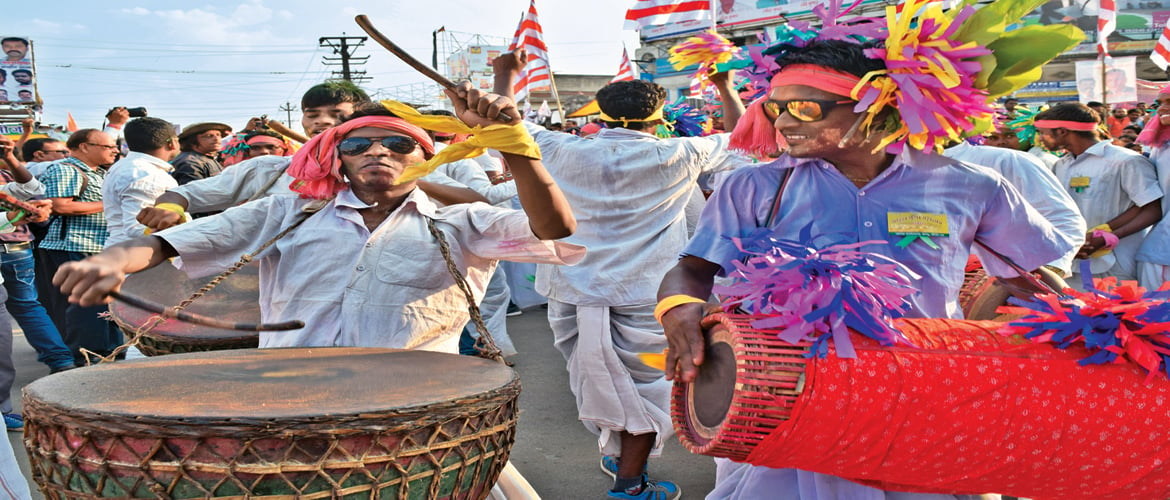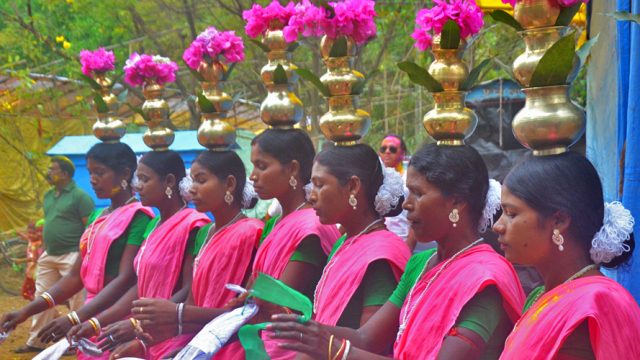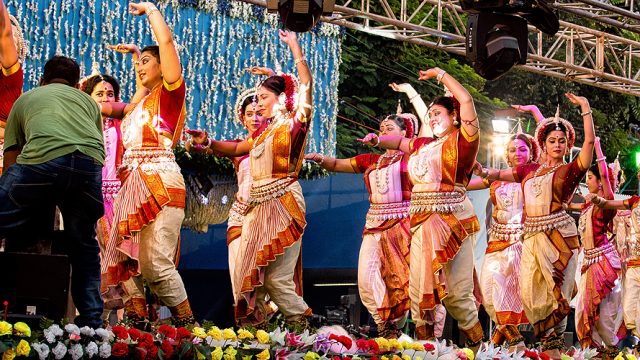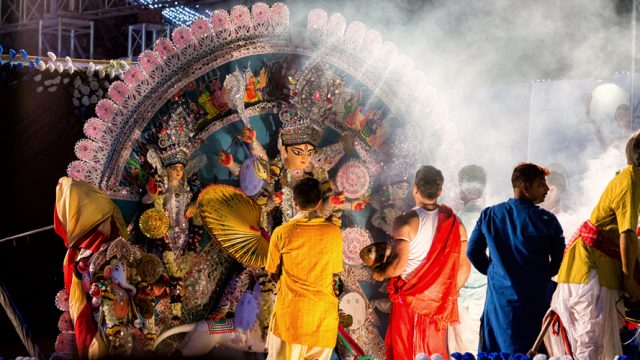Type Tribal Festival Time 3 Days In March/ April Location Hatma Village, Ranchi, Jharkhand Worshipping a tree for
Sarhul is one of India’s unique tribal festivals in which thousands of men, women and children sporting unique headgears, bandanas, anklets, bangles, and henna tattoos, gather in their towns and villages every year to give thanks to the sal tree. This three-day festival is at its liveliest on the final day when tribals and visitors alike, dance their way through the streets in the shobha yatra (grand procession) from Birsa Munda roundabout till Seramtoli in Ranchi to loud Nagpuri songs.
Several rituals take place between the first day and the shobha yatra, some of which can make spectators’ stomachs turn, such as the sacrificial offering of hens.
History
The word ‘sarhul’ roughly translates to the ‘worship of sal’. The festival lasts for three days starting from the third day of the month of Chaitra (March–April). There are over 30 tribal groups in Jharkhand and all of them observe this centuries-old festival. The tribals pay their obeisance to the sal tree for providing them with food, drink, shade, shelter, livelihood, prediction of harvest and weather, and even protection from the evil eye all year round.
“Sal hume jeevan deti hai (Sal gives us life),” says Jaglal Pahan, the priest at Hatma village in Ranchi District. “Hume ye vipatti se bhi bachati hai (She also saves us from calamities)”, he added.

The sal tree is the most important source of timber in Jharkhand and its leaves are used to make bowls in which offerings are made to deities during festivals. The leaves are also used to make paan (sal leaf filled with sweeteners and spices, and used as a mouth freshner). The resin is used as an astringent in Ayurvedic medicines while sal seeds are used for making lamp oil. Forest dwellers also wrap tobacco in sal leaves to make chutta (cigarettes).
Orientation
Although Ranchi is a small town, it is well connected to all major towns via flights, trains and buses. Within the city, public transport is practically non-existent and the best option is hiring a taxi. There are autos and cycle rickshaws for short distances.
The Festival
Like most non-tribal residents of Jharkhand, I had seen Sarhul festivities since childhood but never quite understood the essence of the festival and the importance of tree worship – until this year.
While Sarhul festival is celebrated even in the most isolated pockets of Jharkhand, it’s the state capital and its outskirts that host the largest and grandest celebrations. So, I headed straight to Ranchi, arriving on the second day of the festival. The Birsa Munda Airport wore a deserted look since the tribal staff members were on leave and only a handful of officers were catering to passengers. A Nagpuri song was playing over the intercom, the music composed of the heavy beats of rural instruments, supported by a slightly nasal tone of a man singing praises of the sal tree.

It was unbearably hot outside and I got into a taxi as quickly as I could with the intent of heading straight to the city centre. The blazing heat hadn’t deterred the tribals from carrying out community prayers throughout the day and performing the delightful jadur dance in traditional attire. Bright red and white triangle-shaped prayer flags had been planted on road dividers and in front of every tribal home on the way. Amidst a thicket of trees in Dhurwa village, I saw a cluster of freshly painted tribal homes and kids gorging on colourful fruits.
In the evening, I went to Hatma village to meet the pahan (local priest). He informed me that I hadn’t missed much on the previous day. The first day of the festival usually focuses on the decoration of the areas around sal trees, known as sarna sthal (place of worship). Tribals observe a fast and procure raw materials – arwa rice, urad dal, crabs and fish in preparation for the rituals on the following day. At night they plaster the ground with cow dung and place two pitchers filled with water under sal trees.
Of all the rituals performed during Sarhul, the most notable is the weather prediction ceremony. And the water-filled pitchers are used precisely for this purpose.
The second day of Sarhul began with the pahan checking the water level in the pitchers. Since it had gone down, he predicted scanty rainfall in the region for the coming year. Locals claim the prediction has never been wrong. Such is the importance of this ceremony that the prediction made front-page headlines in the local newspapers the following day.
Later that evening, the pahan made a sacrificial offering of three roosters (white, black and brown), a ritual to keep the tribal deity Singhbhonga, also known as Dharmesh, happy. Then a prasad called tehri, which is made from the sacrificed chickens, rice and dal was distributed to everyone.
The third day began fairly early at the Tribal and Regional Languages Department of Ranchi University at Morabadi, where I had been invited to attend the morning prayers.
Men dressed in white vests and dhotis, and women in padiyas (white saris with red borders) sporting headgears made out of sal twigs were standing around a tree. The priest prayed for harvest by offering the deity crabs and fish. The meat was then pounded into a paste and mixed with paddy seeds and set aside. It would later be sown in the fields. After the prayers, the pahan offered sal flowers to his wife and others in the crowd, inserting them in to the headgears – a ceremony called phoolkhonsi. The devotees then drank hadiya – this rice beer is made from rice flour mixed with a special forest grass and then left to ferment with cooked rice for six days – and started assembling at the sarna sthal for the last lap and the grandest part of the festival – the shobha yatra.
The shobha yatra began with a loud beating of drums and ululating at the sarna sthal in Morabadi. The city shuts down after 12.00pm to make way for the procession and roads from Birsa Munda Chowk till Seramtoli are barricaded to prevent vehicular movement.
Hundreds of tribals danced their way towards Birsa Munda Chowk, throwing abeer (coloured powder) in the air and on each other. They had also brought a couple of jhankis (a beautiful float displaying rural life) with them.

A large audience had gathered on the roadside to watch the festival. Others sat comfortably on the terrace of the tall Firayalal building, which overlooks the Birsa Munda roundabout and the long stretch ahead till Sujata Chowk. This is the best point to view the procession.
Later in the night, after offering prayers at the sarna sthal in Seramtoli, the crowd retired to their houses for a grand feast comprising dhuska (a deep-fried roll of rice, dal and spices served with spicy mint chutney), bharra, pittha, chhilka (a deep-fried, paper-thin dosa made of rice flour and spices), dumbu, cham cham mithai and dhuta.
Things to See
Nestled in east India, the forests of Jharkhand are largely untouched by human habitation and rarely visited by outsiders, except in the hill station of Netarhat, the pilgrimage site of Deoghar and Rikhia’s Yogashram. Besides Ranchi, the industrial towns of Jamshedpur and Bokaro, and the coal city of Dhanbad, Jharkhand remains a rural state. Well-connected by roads, the landscape is a photographer’s delight and is perfect for long drives.
There are a few notable waterfalls such as Dassam, Hundru, Jonha and Lodh, on the outskirts of the city. They can be visited over the course of a day trip. Betla National Park in Latehar District and the Anglo-Indian settlement of McCluskieganj are also interesting places to visit around Ranchi. Contrary to popular belief that the state is largely unsafe to travel in due to the presence of Naxals, tourism is actually growing by leaps and bounds here. There are CRPF personnel posted at every stretch to keep you safe.
Shopping
If you’re interested in buying tribal handicrafts, head to Jharcraft on the Main Road. There is also an outlet on Kanke Road. Everything from home furnishing, apparel, pottery, sculptures, handbags, terracotta earrings, bracelets, necklaces, footwear and other accessories are available here.
Where to Stay
The best place to stay in Ranchi is undoubtedly the Radisson Blu (Tel: 0651-6602222; Tariff: ₹7,000–17,000), with great ambience, a swimming pool and delicious food. It also offers a spa and a pastry shop.
Chanakya BNR (Tel: 2461211-14; Tariff: ₹5,500–10,000) is located on Station Road with elegant, modern rooms and suites. It also offers heritage suites. The multi-cuisine and oriental restaurants serve good food and the bar is well stocked. Other high-end options include Capitol Hill (Tel: 2331331; Tariff: Rs.6,000–11,000) on Main Road, Hotel AVN Grand (Tel: 3010909, 2332861; Tariff: ₹4,000–15,000) opposite GEL Church, Hotel Ranchi Ashok (Tel: 2480759-65; Tariff: ₹4,000–12,000) in Doranda, Le Lac Hotel (Tel: 2219511-13; Tariff: ₹5,100–12,000) in Ahirtoli, Park Prime Ranchi (Tel: 2552154-55, 57-58; Tariff: ₹6,500–30,000) in North Morabadi Maidan, Hotel Maple Wood (Tel: 2460801-04; Tariff: ₹3,400–12,000) in Siromtoli Chowk, and Green Horizon (Tel: 6458522/ 33/ 44; Tariff: ₹3,500–14,000) on Station Road. All are equipped with restaurants, Internet and other modcons.
Amongst the more affordable stay options are Jharkhand Tourism’s Birsa Vihar (Tel: 2332816; Tariff: ₹2,200–3,500) on Main Road, Hotel Accord (Tel: 2460025/ 45, 3010900; Tariff: ₹2,500–3,500) on Station Road, Hotel Landmark (Tel: 2560051-55; Tariff: ₹2,250–7,000) near Lalpur Chowk, and Hotel Element (Tel: 2461935-38, 6556605; Tariff: ₹3,500–5,500), also situated on Station Road. Restaurants and other facilities are available at all.
Fast Facts
Tourist Office: Department of Tourism, Government of Jharkhand, FFP Bhawan, 2nd Floor, Dhurwa, Ranchi,
Tel: 0651-2400981/ 493
STD code 0651
Getting There
Air Ranchi’s Birsa Munda Airport has regular flights to New Delhi, Patna and Mumbai. Flights to and from Bengaluru and other state capitals go via Kolkata or Mumbai. Taxi fare to the downtown area is about ₹200–300
Rail Ranchi is well connected to many major cities with direct trains from Delhi, Kolkata, Bengaluru, Chennai, Alleppey, Mumbai and Patna
Road NH23 and NH33 pass through the state capital of Jharkhand offering excellent connectivity to many towns and cities Bus Private Volvo services are the best option and they cost about ₹800–1000 from Kolkata. Log on to redbus.in for more fares. ST buses offer connectivity to many destinations in the state. A full day cab within the city costs ₹1,000 (fuel charges extra)
Inputs by Karen Faye D’Souza
Hatma Village
Jharkhand
March Festivals





